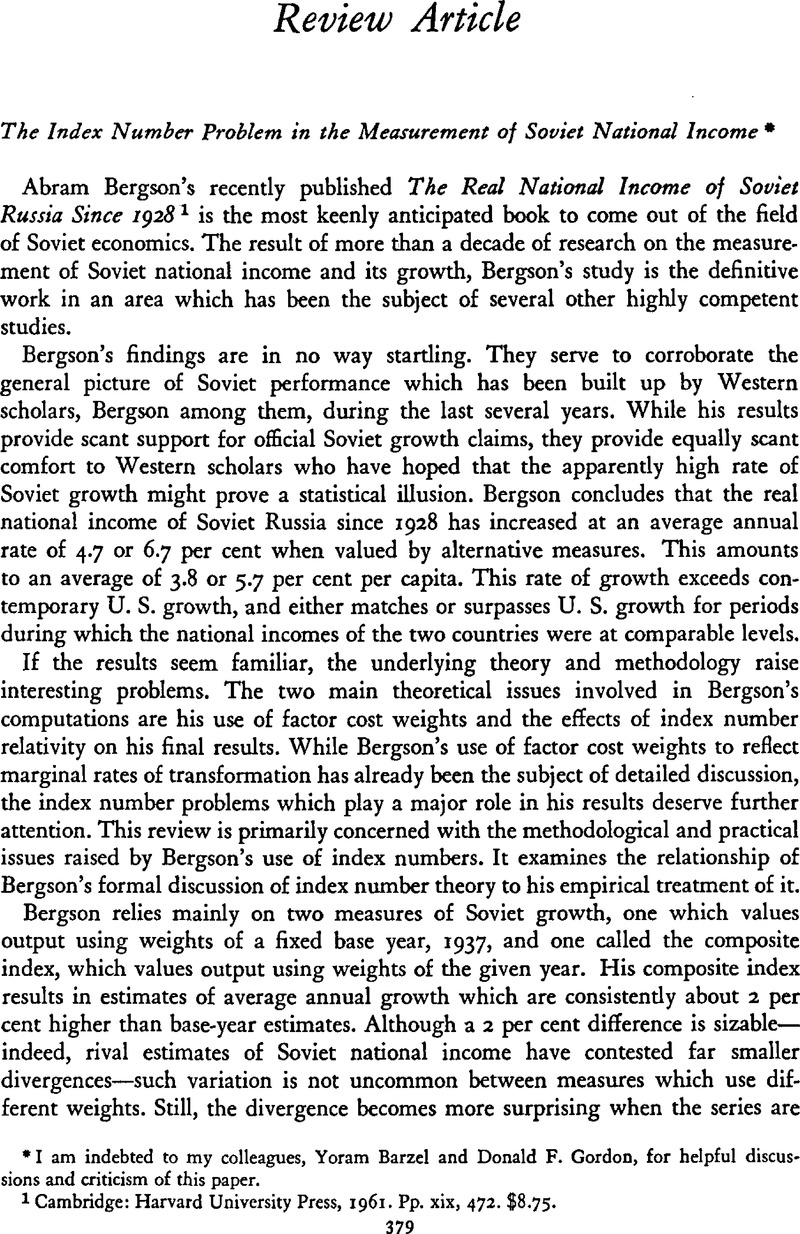No CrossRef data available.
Article contents
The Index Number Problem in the Measurement of Soviet National Income*
Review products
Published online by Cambridge University Press: 03 February 2011
Abstract

- Type
- Review Article
- Information
- Copyright
- Copyright © The Economic History Association 1962
References
1 Cambridge: Harvard University Press, 1961. Pp. xix, 472. $8.75.
2 Charles Schultze of the University of Maryland has most helpfully suggested changes in this section to increase clarity.
3 If curvature is slight, as in segments W1 and ![]() in Figure 4, the Laspeyres ratio,
in Figure 4, the Laspeyres ratio, ![]() , is a better estimate of the true ratio
, is a better estimate of the true ratio ![]() than is the Paasche,
than is the Paasche, ![]() , and the Paasche ratio
, and the Paasche ratio ![]() is a better estimate of the true ratio,
is a better estimate of the true ratio, ![]() , than is the Lespeyres measure
, than is the Lespeyres measure ![]() . If curvature is marked, as with segments W2 and
. If curvature is marked, as with segments W2 and ![]() , the Laspeyres measure
, the Laspeyres measure ![]() is a better estimate of the true ratio
is a better estimate of the true ratio ![]() and the Paasche measure
and the Paasche measure ![]() is a better estimate of the true ratio
is a better estimate of the true ratio ![]() .
.
4 When curvature is slight, as with E1 and ![]() in Figure 5, the Laspeyres ratio
in Figure 5, the Laspeyres ratio ![]() is a superior estimate of the true change
is a superior estimate of the true change ![]() and the Paasche ratio
and the Paasche ratio ![]() is a better estimate of the true change
is a better estimate of the true change ![]() . When curvature is marked, as with E2 and
. When curvature is marked, as with E2 and ![]() , the Laspeyres ratio
, the Laspeyres ratio ![]() is a better estimate of the true change
is a better estimate of the true change ![]() while the Paasche ratio
while the Paasche ratio ![]() is a better estimate of the true change
is a better estimate of the true change ![]() .
.
5 In measuring the direction of bias, the Laspeyres ratio should be considered on the second vector and the Paasche on the first. Whenever the function considered is homogeneous, each measure will give an ambiguous estimate of the direction of bias on the other vector. This is shown in Figure 5, where the Laspeyres estimate on vector 2, ![]() is unambiguously an underestimate of the true change in capacity to produce the second mix whether the production possibilities locus is E1 or E2, but where the Laspeyres ratio on the first vector,
is unambiguously an underestimate of the true change in capacity to produce the second mix whether the production possibilities locus is E1 or E2, but where the Laspeyres ratio on the first vector, ![]() is an underestimate of the true change on vector 1 when curvature is slight but an overestimate when curvature is marked. Similar conclusions may be developed for the Paasche ratio along vector 2.
is an underestimate of the true change on vector 1 when curvature is slight but an overestimate when curvature is marked. Similar conclusions may be developed for the Paasche ratio along vector 2.
6 A similar result can sometimes be obtained using a welfare standard when the Paasche index exceeds the Laspeyres, but this is atypical, whereas such results will be typical for the estimation of change in production potential whenever Gerschenkron's hypothesis about relative price changes holds true. The only case where the true estimates of efficiency might fall between the Laspeyres and Paasche indices in Bergson's series is when the Paasche exceeds the Laspeyres— and even then bracketing is not assured.
7 While adding information about midperiod changes, it is interesting to note that a chain linked index might actually prove an inferior estimate of change for the period as a whole, because there appears to be a reversal in the trend of relative marginal rates of substitution between commodities which were increasing slowly and those which were increasing most rapidly. This is suggested by the fact that the Paasche measure exceeds the Laspeyres in the period 1944 to 1950. (See the charts on pp. 217 and 226.)


